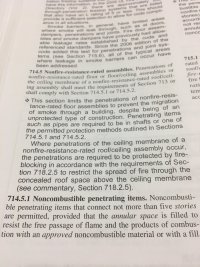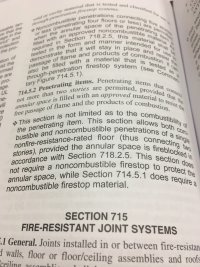JT3ID
REGISTERED
When the IBC (in this case NYC BC version) building construction type allows 0hr, unrated horizontal assembly for floor construction (IIIB for example), floor penetrations must still be filled per 713.4.2, which allows for 'approved material' to resist the free passage of flame or smoke if the penetration is a single floor (connects 2 stories), and allows for noncombustible penetrating items to penetrate up to 3 stories if the penetrations are filled with an 'approved noncombustible material' or with a tested firestop system.
I have been searching without any luck for a 'tested firestop system' that achieved some rating proving 'resistance to the passage of flame (some F rating, say 1hr) or the products of combustion (smoke barrier compliant L rating)' that was tested with a 0hr wood framed floor (2x10's with 3/4" subfloor and 3/4" wood finish floor, no GWB on bottom of joists. All of the tested penetration systems seem to require the GWB on the bottom of joists which is part of a common 1hr floor system. The unrated situation without GWB maybe rare because the floor is 'unrated', why would one test it... well to prove compliance with 713.4.2. I was hoping to find a UL system to hand to the contractor and inspector for clarity.
Does such a tested system exist, providing a tested listing for compliance with 713.4.2? (Ideal for contractor's confidence)
Or is the point of this part of the code that it need not be a fully tested system - the use of a fire stopping product that has been 'tested and classified for use' as part of a similar system (UL L501 for example, with GWB on bottom of joists and 1hr rating) would be compliant with in this case where there is no stated time value required, and the overall system must simply 'resist the free passage of flame and the products of combustion'?
IE would you be compliant with 713.4.2 if you use 3/4" thick Hilti FS One Sealant or FS One Max Intumescent Sealant (1hr F and compliant L ratings achievable) at the penetration of the wood floor, but there was no GWB at bottom of joists and thus no second seal. The idea being a detail similar to UL XHEZ.F-C-1059 or UL XHEZ.F-5088 but without the GWB for a 1hr overall assembly and tested 1hr F and L ratings.
Seems other 'approved' materials would work as well but the typical firestopping product seems the quickest way to confidence of an 'approved' material for installer and inspector.
Thoughts?
Below is the NYC BC version of the IBC where this project occurs.
713.4.2
Nonfire-resistance-rated assemblies.
Penetrations of nonfire-resistance-rated floor or floor/ceiling assemblies or the ceiling membrane of a nonfire-resistance-rated roof/ceiling assembly shall meet the requirements of Section 708 or shall comply with Sections 713.4.2.1through 713.4.2.2
713.4.2.1
Noncombustible penetrating items.
Noncombustible penetrating items that connect not more than three stories are permitted provided that the annular space is filled with an approved noncombustible material or with a fill, void or cavity material that is tested and classified for use in through-penetration firestop systems.
713.4.2.2
Penetrating items.
Penetrating items that connect not more than two stories are permitted provided that the annular space is filled with an approved material to resist the free passage of flame and the products of combustion.
I have been searching without any luck for a 'tested firestop system' that achieved some rating proving 'resistance to the passage of flame (some F rating, say 1hr) or the products of combustion (smoke barrier compliant L rating)' that was tested with a 0hr wood framed floor (2x10's with 3/4" subfloor and 3/4" wood finish floor, no GWB on bottom of joists. All of the tested penetration systems seem to require the GWB on the bottom of joists which is part of a common 1hr floor system. The unrated situation without GWB maybe rare because the floor is 'unrated', why would one test it... well to prove compliance with 713.4.2. I was hoping to find a UL system to hand to the contractor and inspector for clarity.
Does such a tested system exist, providing a tested listing for compliance with 713.4.2? (Ideal for contractor's confidence)
Or is the point of this part of the code that it need not be a fully tested system - the use of a fire stopping product that has been 'tested and classified for use' as part of a similar system (UL L501 for example, with GWB on bottom of joists and 1hr rating) would be compliant with in this case where there is no stated time value required, and the overall system must simply 'resist the free passage of flame and the products of combustion'?
IE would you be compliant with 713.4.2 if you use 3/4" thick Hilti FS One Sealant or FS One Max Intumescent Sealant (1hr F and compliant L ratings achievable) at the penetration of the wood floor, but there was no GWB at bottom of joists and thus no second seal. The idea being a detail similar to UL XHEZ.F-C-1059 or UL XHEZ.F-5088 but without the GWB for a 1hr overall assembly and tested 1hr F and L ratings.
Seems other 'approved' materials would work as well but the typical firestopping product seems the quickest way to confidence of an 'approved' material for installer and inspector.
Thoughts?
Below is the NYC BC version of the IBC where this project occurs.
713.4.2
Nonfire-resistance-rated assemblies.
Penetrations of nonfire-resistance-rated floor or floor/ceiling assemblies or the ceiling membrane of a nonfire-resistance-rated roof/ceiling assembly shall meet the requirements of Section 708 or shall comply with Sections 713.4.2.1through 713.4.2.2
713.4.2.1
Noncombustible penetrating items.
Noncombustible penetrating items that connect not more than three stories are permitted provided that the annular space is filled with an approved noncombustible material or with a fill, void or cavity material that is tested and classified for use in through-penetration firestop systems.
713.4.2.2
Penetrating items.
Penetrating items that connect not more than two stories are permitted provided that the annular space is filled with an approved material to resist the free passage of flame and the products of combustion.



